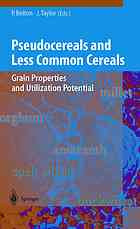

Most ebook files are in PDF format, so you can easily read them using various software such as Foxit Reader or directly on the Google Chrome browser.
Some ebook files are released by publishers in other formats such as .awz, .mobi, .epub, .fb2, etc. You may need to install specific software to read these formats on mobile/PC, such as Calibre.
Please read the tutorial at this link: https://ebookbell.com/faq
We offer FREE conversion to the popular formats you request; however, this may take some time. Therefore, right after payment, please email us, and we will try to provide the service as quickly as possible.
For some exceptional file formats or broken links (if any), please refrain from opening any disputes. Instead, email us first, and we will try to assist within a maximum of 6 hours.
EbookBell Team

4.0
46 reviewsThis book, written by leading grain scientists from Europe and Africa, examines six such grains that have been important food crops in various parts of the world and have the potential for much greater and more widespread use. The chemistry, nutritional value, food processing technologies and potential applications of three true cereals: sorghum, spelt wheat and the major millet species, and three dicotyledonous pseudocereals: grain amaranth, buckwheat and quinoa are discussed. Just three cereal grains account for more than 75% of all grains produced worldwide. This causes high risks for the future of humankind via catastrophic food crop failures and is detrimental to our long-term health (deficiencies of micronutritients, food allergenes and intolerances). In addition, the intensive cultivation practices needed to produce the required high yields of these cereals is frequently leading to environmental degradation, and they are often inappropriate in the Developing World.